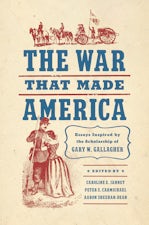Gettysburg--The Second Day
By Harry W. Pfanz
624 pp., 6 x 9, 84 illus., 13 maps, appends., notes, bibl., index
-
Paperback ISBN: 978-0-8078-4730-5
Published: March 1998 -
E-book EPUB ISBN: 978-0-8078-6973-4
Published: June 2011 -
E-book PDF ISBN: 979-8-8908-7403-0
Published: June 2011
Civil War America
Buy this Book
- Paperback $36.00
- E-Book $19.99
Harry Pfanz, a former historian at Gettysburg National Military Park, has written a definitive account of the second day's brutal combat. He begins by introducing the men and units that were to do battle, analyzing the strategic intentions of Lee and Meade as commanders of the opposing armies, and describing the concentration of forces in the area around Gettysburg. He then examines the development of tactical plans and the deployment of troops for the approaching battle. But the emphasis is on the fighting itself. Pfanz provides a thorough account of the Confederates' smashing assaults -- at Devil's Den and Litle Round Top, through the Wheatfield and the Peach Orchard, and against the Union center at Cemetery Ridge. He also details the Union defense that eventually succeeded in beating back these assaults, depriving Lee's gallant army of victory.
Pfanz analyzes decisions and events that have sparked debate for more than a century. In particular he discusses factors underlying the Meade-Sickles controversy and the questions about Longstreet's delay in attacking the Union left. The narrative is also enhanced by thirteen superb maps, more than eighty illustrations, brief portraits of the leading commanders, and observations on artillery, weapons, and tactics that will be of help even to knowledgeable readers.
Gettysburg--The Second Day is certain to become a Civil War classic. What makes the work so authoritative is Pfanz' mastery of the Gettysburg literature and his unparalleled knowledge of the ground on which the fighting occurred. His sources include the Official Records, regimental histories and personal reminiscences from soldiers North and South, personal papers and diaries, newspaper files, and last -- but assuredly not least -- the Gettysburg battlefield. Pfanz's career in the National Park Service included a ten-year assignment as a park historian at Gettysburg. Without doubt, he knows the terrain of the battle as well as he knows the battle itself.
About the Author
Harry W. Pfanz is author of Gettysburg--Culp's Hill and Cemetery Hill. He served ten years as a historian at Gettysburg National Military Park and retired from the position of Chief Historian of the National Park Service in 1981.
For more information about Harry W. Pfanz, visit
the
Author
Page.
Reviews
“A definitive account of the second day’s brutal combat.” —Susquehanna Life
"For Civil War readers not familiar with Harry Pfanz, be advised that he is today the greatest living authority on Gettysburg. . . . What he has done here is to produce the most complete account of the main fighting on July 2 that will ever be written. . . . Both a fast-paced narrative and an all-inclusive encyclopedia. . . . If only such books like this existed for the other stages of the great battle of Gettysburg."—James I. Robertson Jr., Richmond News-Leader
"[Pfanz] put in a 10-year stint at Gettysburg, and he knows the ground there about as well as it is possible to know it. He brings this knowledge to Gettysburg—The Second Day, and along with it meticulous research and a vigorous, lucid sense of narrative. . . . A tribute worthy of the efforts of the men who took part in what the Confederate Gen. James Longstreet called 'the best three hours' fighting ever done by any troops on any battle-field.'"—Richard Snow, New York Times Book Review
"Pfanz appears to have found out everything that can be known about the fighting on July 2, about the maneuverings that led to it, about the armies that collided so fatefully in the rolling Pennsylvania farm country, and about the men who led them—right down to the sergeants and lieutenants, without whom armies seldom would be led anywhere."—Tom Wicker, Atlantic Monthly




